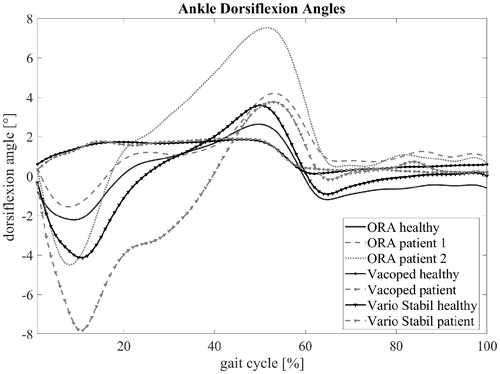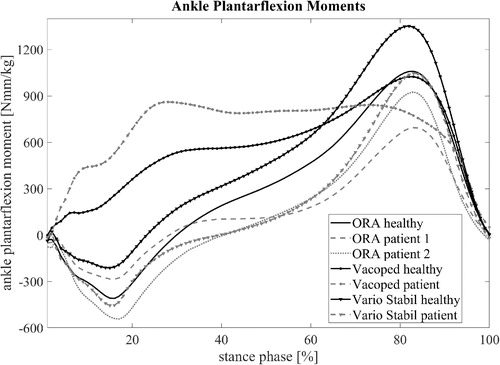Introduction
Achilles tendon injuries (ATI), such as a partial or complete rupture, are common in the adult population. Such injuries can be treated either by immobilization via cast or with functional rehabilitation, including weight bearing with the ankle kept in a plantarflexed position (Frankewycz et al., Citation2017). The functional treatment improves patient satisfaction and shortens the time until returning to activities of daily life, without increasing the risk of complications (Ecker et al., Citation2016; McCormack & Bovard, Citation2015). To achieve this, orthopaedic boots with the aim to reduce Achilles tendon (AT) loading are used. However, only limited research has been done assessing their influence on walking biomechanics with human participants.
Purpose of the study
The aim of this study is to investigate the influence of different orthopaedic boots on lower extremity biomechanics during walking.
Methods
Three types of orthopaedic boots commonly used for the treatment of acute ATI were tested by healthy subjects (HE) and ATI patients (PAT): Vacoped (OPED AG), Ortho Rehab Absolut (ORA, Kuenzli SwissSchuh AG) and Vario Stabil (Orthotech GmbH), all in the maximal plantarflexion setting.
The 10 HE and 4 PAT underwent a gait analysis: HE walked with each product; PAT walked with their prescribed product only.
Gait data were captured by a marker-based, optoelectronic motion capturing system (Vicon Nexus, 240 Hz), as well as two force plates (AMTI, 1200 Hz). All subjects walked at 1.2 m/s. Sagittal ankle range of motion (sA_ROM) was used as a measure of boot stability, while the peak ankle plantarflexion moment (pA_PFM) led to an estimate of AT loading. Additionally, the centre of pressure (COP) was recorded.
For the HE, differences between boots were analyzed by a repeated-measures ANOVA while PAT were analyzed descriptively.
Results
For the HE, all products differed significantly in the sA_ROM, with Vacoped showing 1.8 (0.3)°, ORA 5.0 (1.3)° and Vario Stabil 7.9 (1.7)°. The PAT with Vacoped showed a similar sA_ROM as the HE, while PAT with Vario Stabil and ORA showed increased sA_ROM ().
The largest pA_PFM was observed in Vario Stabil, which differed significantly from the other two products (for HE). All PAT showed a smaller pA_PFM than the corresponding HE ().
In the HE, the COP of ORA and Vario Stabil stayed close to the ankle joint centre for a longer period than for Vacoped, resulting in a smaller initial moment. A longer proximity of the COP to the joint was also recorded for PAT with ORA and Vario Stabil.
Discussion and conclusion
All boots influenced gait variables to a different extent. Based on sA_ROM, Vacoped showed the highest stability. For ORA and Vario Stabil, the PAT showed larger sA_ROM compared to HE. The HE had their boots tightened by the investigator while PAT did this themselves. This could have resulted in a looser fitting of the shoes for PAT. Also, the longer wearing time of the prescribed boots could have led to material changes.
For PAT, the smallest pA_PFM was obtained with ORA. The rounded shoe sole construction led to the COP being closer to the ankle joint and, therefore, reducing the maximal joint moment and potentially the AT loading. Conclusions about loading of the AT is limited by the chosen approach using surface markers mounted on the boot.
Overall, all boots were successful at reducing loading of the Achilles tendon or range of motion of the ankle. Future research is needed to determine the desired range of those variables to select the most appropriate boot.
Disclosure statement
No potential conflict of interest was reported by the author(s).
Additional information
Funding
References
- Ecker, T. M., Bremer, A. K., Krause, F. G., Müller, T., & Weber, M. (2016). Prospective Use of a Standardized nonoperative early weightbearing protocol for achilles tendon rupture: 17 Years of experience. American Journal of Sports Medicine, 44, 1004–1010. https://doi.org/10.1177/0363546515623501
- Frankewycz, B., Krutsch, W., Weber, J., Ernstberger, A., Nerlich, M., & Pfeifer, C. G. (2017). Rehabilitation of Achilles tendon ruptures: Is early functional rehabilitation daily routine? Archives of Orthopaedic and Trauma Surgery, 137, 333–340. https://doi.org/10.1007/s00402-017-2627-9.
- McCormack, R., & Bovard, J. (2015). Early functional rehabilitation or cast immobilization for the postoperative management of acute Achilles tendon rupture? A systematic review and meta-analysis of randomized controlled trials. British Journal of Sports Medicine, 49, 1329–1335. https://doi.org/10.1136/bjsports-2015-094935


